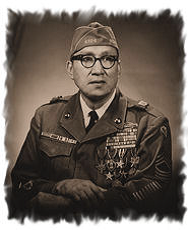|
Submitted by Jim Hornstra from the South Dakota Archives  MASTER SERGEANT WOODROW WILSON KEEBLE Woodrow Wilson Keeble was born in Waubay, South Dakota, to Isaac and Nancy (Shaker) Keeble on May 16, 1917. While still very young, he moved to Wahpeton, North Dakota, where his mother worked at the Wahpeton Indian School (now called Circle of Nations School). Woodrow excelled in athletics, especially baseball, and pitched the Wahpeton amateur team to ten straight victories. He was being recruited by the Chicago White Sox when his Army National Guard unit was called up to serve in World War II. In World War II, Keeble served with I Company of the famed North Dakota 164th Infantry Regiment. After initial training in Louisiana, the regiment deployed to Australia in preparation for operations in the Pacific Theater. Keeble's unit was assigned to the Americal Division (officially the 23th Infantry Division). The 164th landed on Guadalcanal on October 13, 1942, to help the battered First Marine Division clear the South Pacific island of Japanese. Keeble's regiment of Dakotans was the first United States Army unit to conduct an offensive operation against the enemy in any theater. During these battles, Keeble's reputation for bravery and skill grew. Nearly a head taller than most of his fellow soldiers, he was an expert with the Browning Automatic Rifle (BAR). His other great weapon was his pitching arm, which he used to hurl hand grenades with deadly accuracy. James Fenelon, a member of the Standing Rock Sioux Tribe of North and South Dakota who fought with Keeble on Guadalcanal, once remarked that “The safest place to be was right next to Woody.” After the battles on Guadalcanal, Keeble and the rest of the regiment participated in combat campaigns on the islands of Bougainville, Leyte, Cebu, and Mindanao. Following the Japanese surrender, the entire Americal Division landed in Japan and took part in the occupation of the Yokohama region. After the war, Keeble returned to Wahpeton and worked at the Wahpeton Indian School. In 1947, Woodrow Wilson Keeble married Nettie Abigail Owen-Robertson. The 164th Infantry Regiment was reactivated in 1951 during the Korean War; they trained at Camp Rucker, Alabama. When Keeble's commanding officer had to select several sergeants for deployment to the front lines, he decided to have his men draw straws. Keeble volunteered instead. Asked why, Keeble said, “Somebody has to teach these kids how to fight.” Keeble, described as a gentle giant by his friends, was a ferocious warrior in battle, as evidenced by his heroic actions during Operation Nomad-Polar. Official records confirm Keeble was initially wounded on October 15, and then again on October 17, 18, and 20 - for which he received only one Purple Heart. For his bravery on the 18th, he was awarded a Silver Star. His heroism on the 20th made Keeble a legend - and 57 years later resulted in his posthumous Medal of Honor. His bravery in the face of enemy fire was so remarkable that a recommendation that he receive the Medal of Honor was twice submitted. In both cases, the recommendation was lost. When Keeble's men endeavored to submit the recommendation a third time, officials informed them they were too late; the 24th Division had reached its quota of Medal of Honor recipients. After reconsideration, Keeble was awarded the Congressional Medal of Honor by President George W. Bush, and was the first Sioux Indian to receive this award. Woodrow W. Keeble died January 28, 1982, and is buried at Sisseton, South Dakota. The President of the United States of America, authorized by Act of Congress, March 3, 2008, has awarded in the name of Congress the Medal of Honor to MASTER SERGEANT WOODROW W. KEEBLE UNITED STATES ARMY Citation The President of the United States of America, in the name of Congress, takes pride in presenting the Medal of Honor to Master Sergeant Woodrow W. Keeble, United States Army, for conspicuous gallantry and intrepidity, at the risk of his life, above and beyond the call of duty: In action with an armed enemy near Sangsan-ni, Korea, on 20 October, 1951. On that day, Master Sergeant Keeble was an acting platoon leader for the support platoon in Company G, 19th Infantry, in the attack on Hill 765, a steep and rugged position that was well defended by the enemy. Leading the support platoon, Master Sergeant Keeble saw that the attacking elements had become pinned down on the slope by heavy enemy fire from three well-fortified and strategically placed enemy positions. With complete disregard for his personal safety, Master Sergeant Keeble dashed forward and joined the pinned-down platoon. Then, hugging the ground, Master Sergeant Keeble crawled forward alone until he was in close proximity to one of the hostile machine-gun emplacements. Ignoring the heavy fire that the crew trained on him, Master Sergeant Keeble activated a grenade and threw it with great accuracy, successfully destroying the position. Continuing his one-man assault, he moved to the second enemy position and destroyed it with another grenade. Despite the fact that the enemy troops were now directing their firepower against him and unleashing a shower of grenades in a frantic attempt to stop his advance, he moved forward against the third hostile emplacement, and skillfully neutralized the remaining enemy position. As his comrades moved forward to join him, Master Sergeant Keeble continued to direct accurate fire against nearby trenches, inflicting heavy casualties on the enemy. Inspired by his courage, Company G successfully moved forward and seized its important objective. The extraordinary courage, selfless service, and devotion to duty displayed that day by Master Sergeant Keeble was an inspiration to all around him and reflected great credit upon himself, his unit, and the United States Army.
0 Comments
Leave a Reply. |
Categories
All
Archives
October 2023
|